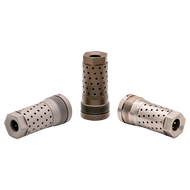Choosing the right muzzle device for use with your Suppressor
Mar 31st 2025
CHOOSING THE RIGHT STYLE MUZZLE DEVICE
- There are many different styles of muzzle devices out there. The three most common are brakes, compensators, and flash hiders. All have their advantages and disadvantages.
- BRAKES: A muzzle brake is primarily designed to reduce felt recoil. Recoil reduction offered from brakes is typically superior compared to that of compensators and flash hiders. A key disadvantage of a muzzle brake is the significant increase in concussion as muzzle brakes are designed to expel the muzzle blast perpendicular. When using a muzzle brake in conjunction with a suppressor the increased muzzle blast to the side becomes a non factor. A great advantage of utilizing a muzzle brake with your suppressor, is the that the muzzle brake acts as a sacrificial blast baffle. This will significantly increase the life of your blast baffle (first baffle in your suppressor). This can be especially important for Titanium and Aluminum suppressors. This is not as much of a factor for steel and Inconel suppressors.
- COMPENSATORS: A compensator primarily aims to reduce muzzle rise by directing escaping gases upwards or in a radial pattern, keeping the sights on target during rapid fire. Although muzzle brakes and compensators share much of the same advantages, there are better uses for one vs the other. A compensator is a great choice for firearms that will be used for sustained fire, as the compensator will do a superior job at keeping you on target. A compensator will also reduce erosion of your suppressor blast baffle as it will redirect the initial blast.
- FLASH HIDERS: A flash hider is designed to minimize the visible muzzle flash from a firearm, primarily used to protect a shooter's vision in low-light or night time conditions. A flash hider will offer little to no recoil reduction, as compared to muzzle brakes and compensators. A flash hider disperses and cools expanding gases exiting the muzzle to minimize visible signature. A flash hider will have little to no effect on protecting your suppressor's initial factor. This is not as much of a concern for steel and Inconel suppressors.
THREAD SIZE COMPATIBILITY
Threads sizes in the world of suppressors can be confusing and frustrating at times. We want to be as transparent as possible when it comes to informing our customers of thread size compatibility. We offer many different thread sizes for mounts, muzzle devices, and adapters. All products will have some form of a description for their thread size. If you have questions regarding thread size compatibility please reach out to us at sales@sdtacticalarms.com. Below are a few common thread sizes.
Common suppressor Mounts sizes
- HUB 1.375x24 (1-3/8x24)
- D-Size 1.4375x20 (1-7/16x20)
- B-Size 1.187x24 (1-3/16x24)
- Alpha 1.125-28 (1-1/8 28)
Tapered mount and muzzle devices
- Plan B (cherry bomb) - 0.9x24 (9/10x24)
Common calibers and associated thread size (Please note these are not true for all firearms)
- 1/2x28 - .223, 5.56, 9mm, 22lr (most all .224 calibers)
- 5/8x24 - .308, 300WM, 6.5CM, 6.5PRC, etc... (most all .243-.338 calibers)
- 9/16x24 - .40S&W, 10mm, and some 6.5mm calibers
- 37/64x28 - .45ACP pistols
SUPPRESSOR CLEANING AND MAITNENCE
- The frequency of cleaning your suppressor depends largely on the type of ammunition you use, with most high-pressure rifle suppressors requiring cleaning only every few thousand rounds, while rimfire suppressors may need cleaning after every few hundred rounds due to the higher fouling buildup from rimfire ammunition.
- Another recommendation to know whether your suppressor needs to be cleaned is to weigh it. If your suppressor has accumulated more than 1 ounce of weight in carbon build up, then it should be cleaned.

